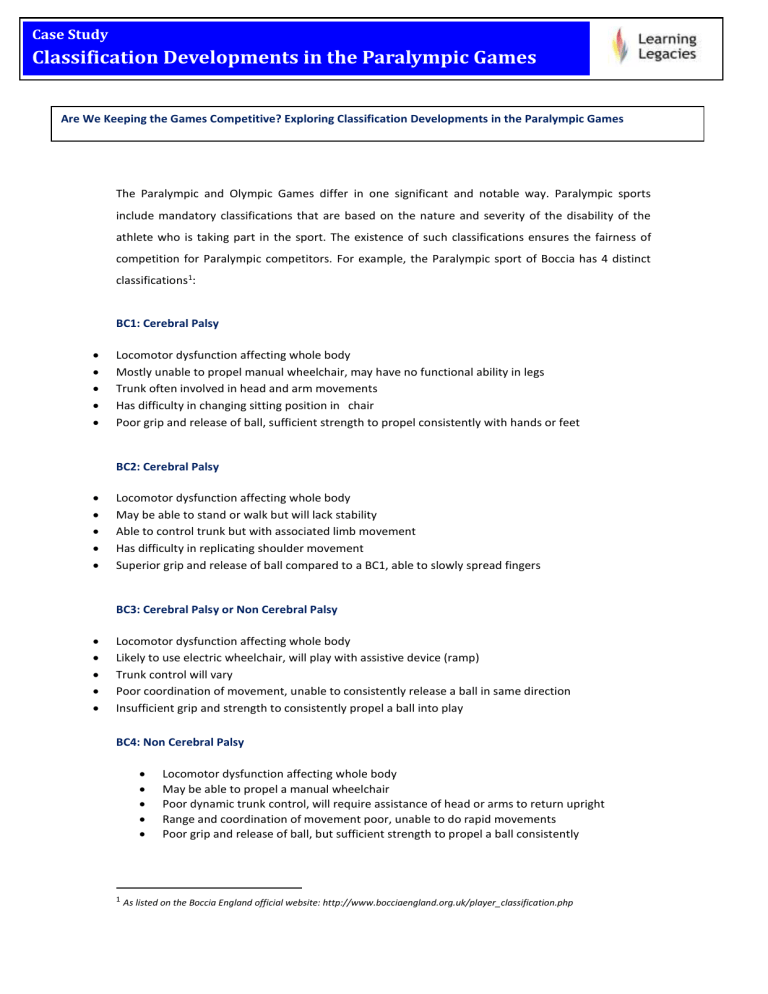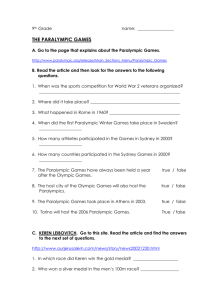Classification Developments in the Paralympic Games

Case Study
Classification Developments in the Paralympic Games
Are We Keeping the Games Competitive? Exploring Classification Developments in the Paralympic Games
The Paralympic and Olympic Games differ in one significant and notable way. Paralympic sports include mandatory classifications that are based on the nature and severity of the disability of the athlete who is taking part in the sport. The existence of such classifications ensures the fairness of competition for Paralympic competitors. For example, the Paralympic sport of Boccia has 4 distinct classifications 1 :
BC1: Cerebral Palsy
Locomotor dysfunction affecting whole body
Mostly unable to propel manual wheelchair, may have no functional ability in legs
Trunk often involved in head and arm movements
Has difficulty in changing sitting position in chair
Poor grip and release of ball, sufficient strength to propel consistently with hands or feet
BC2: Cerebral Palsy
Locomotor dysfunction affecting whole body
May be able to stand or walk but will lack stability
Able to control trunk but with associated limb movement
Has difficulty in replicating shoulder movement
Superior grip and release of ball compared to a BC1, able to slowly spread fingers
BC3: Cerebral Palsy or Non Cerebral Palsy
Locomotor dysfunction affecting whole body
Likely to use electric wheelchair, will play with assistive device (ramp)
Trunk control will vary
Poor coordination of movement, unable to consistently release a ball in same direction
Insufficient grip and strength to consistently propel a ball into play
BC4: Non Cerebral Palsy
Locomotor dysfunction affecting whole body
May be able to propel a manual wheelchair
Poor dynamic trunk control, will require assistance of head or arms to return upright
Range and coordination of movement poor, unable to do rapid movements
Poor grip and release of ball, but sufficient strength to propel a ball consistently
1
As listed on the Boccia England official website: http://www.bocciaengland.org.uk/player_classification.php
Case Study
Classification Developments in the Paralympic Games
WOMENS PARTICIPATION IN THE OLYMPIC GAMES
Classification Rule Changes
Recently, Paralympic sport has found itself subject to a tranche of rule changes that may significantly impact the event. Before exploring the proposed changes, it is at first important to underline the importance of ensuring fairness through the classification system for all Paralympic athletes.
Classification & Fairness within the Paralympic Games
When one considers the concept of a level playing field for the Olympic athlete, the response to such a concept is well developed. Adoption of the World Anti-Doping Association Code of Practice seeks to minimise cheating associated with the use of prohibited substances, such as steroids, or of prohibited practices, such as blood doping. The use of technology remains a concept for debate (perhaps most recently within the case of Oscar Pistorius and his use of prosthetics).
When one considers the Paralympics, these issues remain pertinent, but there is a completely separate issue of classifications of disabilities to consider. The range of disabilities from which an athlete can suffer are varied and complex, and the nature of the Paralympic Games necessitates a system that is complex enough to be inclusive but accessible enough to be implementable by all federations. An additional problem exists in terms of ensuring that there are sufficient numbers of athletes that meet classification requirements in each category in order for competition to take place.
The Classification System
The inception of ‘functional ability classification’ originated during the 1980’s. Athletes were given a specific classification which led to the identification of the category within which the athlete could compete. However, in more recent Games, there have been moves towards an overall assessment of the functional ability of the athlete to participate in a given sport. The athlete is then given an overall rating, based on this assessment of ability, and athletes with different impairments are then able to compete together (dependent on the fact that their ability ratings are the same).
Some Paralympic sports choose to adopt the functional classification, whilst others have chosen a combination of a separation based on type of disability in addition to a classification based on functional ability. Some have adopted a collective disability points system (for example, basketball), where each athlete within the team is given a disability points score, and the points of all athletes are combined. The teams are then limited to the number of representative ‘points’ that can be present on the field at any one time.
Case Study
Classification Developments in the Paralympic Games
WOMENS PARTICIPATION IN THE OLYMPIC GAMES
Issues of Fairness with the Classification System
There is debate regarding the problems associated with the widely used Functional Ability system.
The most major argument centres on the fact the concept of which classification should be used for each athlete can rest on individual opinion, as opposed to a clear classification criteria. For example, if all athletes within a 400m event have lost their lower legs below the knee, then the classification of disability is clearly defined. However, a functional classification of an athletes’ overall ability is far less clear to gauge and less transparent in terms of how the assessment of that particular athletes’ ability was determined. The assessor would need a clear and detailed understanding of all disabilities considered within the athletes that they are assessing, in addition to a detailed knowledge of the sport played, in order to feel capable of comparing overall ability levels in an equitable and fair way.
Fairness Variations Across Paralympic Sports
The International Paralympic Committee (IPC) provides an outline of classifications. However, individual sports federations are ultimately responsible for the decisions made in terms of Functional
Ability ratings, due to their expert knowledge of the sport in question.
A potential issue is raised when one considers the need for athletes to have a consistent number of competitors within their category/sport to compete against. A governing body may not wish to invest resources in a particular classification event if a very small number of competitors exist. This can significantly limit the flexibility of Paralympic athletes to move to a different (but related) event in their event is not available to them. This might lead to Paralympic sports and events to compromise their classification requirements in some areas in order to maximise competitive opportunities for athletes and to ensure that certain events have a requisite number of competitions assured in order for it to take place.
Classification Changes for the London 2012 Paralympic Games
Paralympic classifications are relatively fluid, and evolve over time. At the Beijing Paralympic Games, for example, classifications were actually modified during the event. This led to confusion amongst teams, and highlighted the importance of finalising all classifications before the Games take place. A key focus for the London 2012 Paralympic Games has been to ensure that any planned changes are confirmed before the start of the Games.
Intellectual Disabilities
A major change for the London 2012 Paralympics has been the reintroduction of the Intellectual
Disabilities (ID) category classifications. Whilst this category has formerly existed, insufficient means of classifying athletes had led to significant issues, and the category was temporarily withdrawn.
Case Study
Classification Developments in the Paralympic Games
WOMENS PARTICIPATION IN THE OLYMPIC GAMES
In 2009, the IPC voted to reintroduce the ID classifications, in addition to the development of more robust measures for testing intellectual impairments. A number of sports federations are now seeking to integrate Intellectual Disabilities into their range of classifications.
Paralympic Cycling
Recently, the International Cycling Union (ICU) voted to combine seven classifications in order to enhance competitiveness, and notionally improve the concept of a level playing field. Critics argue that the combination of classifications has made the sport far less fair, as it means that there will now be a far greater range of the severity and nature of disabilities within the athletes who compete.
Assessing a true comparison of ability across such a complex field of competitors is inevitably going to raise complex issues of fairness, and claims of subjectivity in the assessment process.
In order to deal with this potential issue, the ICU has proposed that Paralympic medals be awarded to athletes in relation to their performance as compared with existing world records. This has also led to
(perhaps inevitable) concerns of unfairness across different classifications, as the world record time of one classification (for the same) might be considerably faster than that of another classification. It also carries the impact of athletes seeking to win without exceeding existing world records before the
2012 Games, in order that they do not increase the difficulty level of winning a medal (tied to world records) during the event. Many athletes have campaigned for the removal of this new approach.
The Raza System
Another development, which could be considered less controversial than that proposed by the ICU is the ‘Raza System’; a points scoring system that allows greater cross-over between classifications. The use of this system will be monitored during the 2012 Paralympic Games to assess its robustness and viability.
FURTHER INFORMATION
Boccia England Athlete Classification http://www.bocciaengland.org.uk/player_classification.php
IPC Sport Specific Classification http://www.paralympic.org/Sport/Classification/Classification_Code.html
Case Study
Classification Developments in the Paralympic Games
WOMENS PARTICIPATION IN THE OLYMPIC GAMES
DISCUSSION
1.
Amateur sport relies on the willingness of volunteers to become involved in the sport (coaching, administration, governance, refereeing, etc) in order for it to survive and grow. How might the recruitment of volunteers be made more complex as a result of the many classifications that exist in Paralympic sport?
2.
Debate the pros and cons of the system devised by the ICU.
3.
Research the case of the Paralympic scandal in Sydney 2000 that involved demands for the
Spanish basketball team to return their Gold medals. What does this tell us about the complexities of classification systems?
Case Study
Classification Developments in the Paralympic Games
WOMENS PARTICIPATION IN THE OLYMPIC GAMES
This resource was produced as part of the 2012 Learning Legacies Project managed by the HEA
Hospitality, Leisure, Sport and Tourism Subject Centre at Oxford Brookes University and was released as an Open Educational Resource. The project was funded by HEFCE and part of the JISC/HE Academy
UKOER programme. Except where otherwise noted above and below, this work is released under a
Creative Commons Attribution only licence .
Exceptions to the Licence
The name of Oxford Brookes University and the Oxford Brookes University logo are the name and registered marks of Oxford Brookes University. To the fullest extent permitted by law Oxford Brookes
University reserves all its rights in its name and marks, which may not be used except with its written permission. The JISC logo is licensed under the terms of the Creative Commons Attribution-Non-
Commercial-No Derivative Works 2.0 UK: England & Wales Licence. All reproductions must comply with the terms of that licence.
The Higher Education Academy logo is owned by the Higher Education Academy Limited and may be freely distributed and copied for educational purposes only, provided that appropriate acknowledgement is given to the Higher Education Academy as the copyright holder and original publisher.
Reusing this work
To refer to or reuse parts of this work please include the copyright notice above including the serial number. The only exception is if you intend to only reuse a part of the work with its own specific copyright notice, in which case cite that.
If you create a new piece of work based on the original (at least in part), it will help other users to find your work if you modify and reuse this serial number. When you reuse this work, edit the serial number by choosing 3 letters to start (your initials or institutional code are good examples), change the date section (between the colons) to your creation date in ddmmyy format and retain the last 5 digits from the original serial number. Make the new serial number your copyright declaration or add it to an existing one, e.g. ‘abc:101011:011cs’.
If you create a new piece of work or do not wish to link a new work with any existing materials contained within, a new code should be created. Choose your own 3-letter code, add the creation date and search as below on Google with a plus sign at the start, e.g. ‘+tom:030504’. If nothing comes back citing this code then add a new 5-letter code of your choice to the end, e.g.; ‘:01lex’, and do a final search for the whole code. If the search returns a positive result, make up a new 5-letter code and try again. Add the new code your copyright declaration or add it to an existing one.





